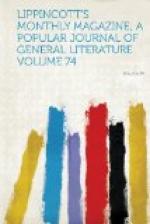Fabulous stories are told of the early wealth and glory of Mattra. Ferishta relates that when Mahmoud of Ghazni had arrived with his troops in the neighborhood in the year 1017, he heard of this rich city consecrated to Krishna Vasu-Deva, and straightway marching upon it captured it and gave it up to plunder. Writing of it afterward to the governor of Ghazni, he declared that such another city could not be built within two centuries; that it contained one thousand edifices “as firm as the faith of the faithful,” and mostly built of marble; that among the temples had been found five golden idols in whose heads were ruby eyes worth fifty thousand dinars; that in another was a sapphire weighing four hundred miskals (the present miskal of Bosrah is seventy-two grains), the image itself producing, after being melted, ninety-eight thousand three hundred miskals of pure gold; and that besides these there were captured one hundred silver idols, each of which was a camel’s load.
We spent a pleasant morning in wandering about the old ruined fort which was built here by Jey Singh (or Jaya Sinha), the famous astronomer, and we were particularly attracted, each in his own contemplative and quiet way, by the ruins of an observatory which we found on the roof of one of the buildings, where the remains of old dials, horizontal circles and mural instruments lay scattered about. I think the only remark made by either of us was when Bhima Gandharva declared in a voice of much earnestness, from behind a broken gnomon where he had ensconced himself, that he saw Time lying yonder on his back, with his head on a broken dial, nearly asleep.
[Illustration: HINDU BANKERS OF DELHI.]
Returning to Hatras Station on the same day, we again took the train, and this time did not leave it until we had crossed the great tubular bridge over the Jumna and come to a standstill in the station at Delhi. Here we found one of the apparently innumerable friends of Bhima Gandharva, a banker of Delhi, awaiting us with a carriage, and we were quickly driven to his residence—a circumstance, by the way, which I discovered next day to be a legitimate matter of felicitation to myself, for there is, strange to say, no hotel in Delhi for Europeans, travelers being dependent upon the accommodations of a dak-bungalow, where one is lodged for a rupee a day.
In the morning we made an early start for the palace of the padishahs, which stands near the river, and indeed may be said to constitute the eastern portion of the city, having a wall of a mile in extent on its three sides, while the other abuts along the offset of the Jumna upon which Delhi is built. Passing under a splendid Gothic arch in the centre of a tower, then along a vaulted aisle in the centre of which was an octagonal court of stone, the whole route being adorned with flowers carved in stone and inscriptions from the Koran, we finally gained the court of the




